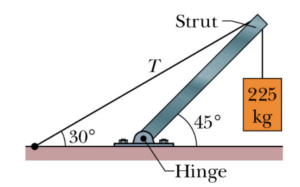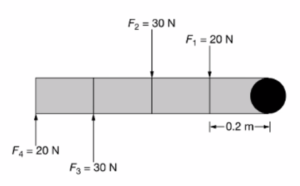0 attempts
0% avg
UBQ Credits
| Step | Derivation/Formula | Reasoning |
|---|---|---|
| Part (a): Determine the final angular speed when power returns. | ||
| 1 | \( v_i = 500\,\text{rpm} \times \frac{2\pi\,\text{rad}}{60\,\text{s}} = \frac{500\times 2\pi}{60} = \frac{50\pi}{3}\,\text{rad/s} \) | Convert the initial speed from revolutions per minute to radians per second. |
| 2 | \( \Delta \theta = 200\,\text{rev} \times 2\pi = 400\pi\,\text{rad} \) | Calculate the total angular displacement during the 30 s power outage (each revolution is \(2\pi\) rad). |
| 3 | \( \Delta \theta = \frac{1}{2}(v_i + v_x)\,t \) | Use the kinematic equation for constant angular acceleration relating displacement, initial and final speeds over time \(t = 30\,s\). |
| 4 | \( v_x = \frac{2\Delta \theta}{t} – v_i = \frac{2(400\pi)}{30} – \frac{50\pi}{3} = \frac{800\pi}{30} – \frac{50\pi}{3} \) | Solve for the final angular speed \(v_x\) after 30 s. |
| 5 | \( \frac{800\pi}{30} = \frac{80\pi}{3}, \quad v_x = \frac{80\pi}{3} – \frac{50\pi}{3} = \frac{30\pi}{3} = 10\pi\,\text{rad/s} \) | Simplify the expression to obtain \(v_x\). This is equivalent to \(10\pi\,rad/s\) which can be converted to \(300\,rpm\) if desired. |
| 6 | \( \boxed{v_x = 10\pi\,\text{rad/s}} \) | Final answer for part (a): the flywheel spins at \(10\pi\,rad/s\) when power returns. |
| Step | Derivation/Formula | Reasoning |
|---|---|---|
| Part (b): Determine the time to stop and total revolutions if power did not return. | ||
| 1 | \( \alpha = \frac{v_x – v_i}{t} = \frac{10\pi – \frac{50\pi}{3}}{30} = \frac{\frac{30\pi – 50\pi}{3}}{30} = -\frac{20\pi}{90} = -\frac{2\pi}{9}\,\text{rad/s}^2 \) | Determine the constant angular deceleration \(\alpha\) using the change in angular velocity over 30 s. |
| 2 | \( 0 = v_i + \alpha T_{\text{stop}} \quad \Rightarrow \quad T_{\text{stop}} = -\frac{v_i}{\alpha} \) | Set the final angular velocity to zero to solve for the total stopping time \(T_{\text{stop}}\) from the moment of power failure. |
| 3 | \( T_{\text{stop}} = -\frac{\frac{50\pi}{3}}{-\frac{2\pi}{9}} = \frac{50\pi}{3} \times \frac{9}{2\pi} = 75\,\text{s} \) | Simplify to find that the flywheel takes 75 s to come to a complete stop. |
| 4 | \( \Delta \theta_{\text{total}} = \frac{v_i + 0}{2}T_{\text{stop}} = \frac{\frac{50\pi}{3}}{2} \times 75 = \frac{50\pi\times75}{6} = 625\pi\,\text{rad} \) | Calculate the total angular displacement using the average angular speed during deceleration. |
| 5 | \( \text{Revolutions} = \frac{625\pi}{2\pi} = 312.5\,\text{rev} \) | Convert radians to revolutions since \(2\pi\) rad correspond to one complete revolution. |
| 6 | \( \boxed{T_{\text{stop}} = 75\,\text{s} \quad \text{and} \quad \text{Total Revolutions} = 312.5\,\text{rev}} \) | Final answers for part (b): the flywheel stops in 75 s making a total of 312.5 revolutions. |
Just ask: "Help me solve this problem."
A net torque is applied to the edge of a spinning object as it rotates about its internal axis. The table shows the net torque exerted on the object at different instants in time. How can a student use the data table to determine the change in angular momentum of the object from \( 0 \) to \( 6 \) \( \text{s} \)? Justify your selection.
| Time \( (\text{s}) \) | Net Torque \( (\text{N} \cdot \text{m}) \) |
|---|---|
| 0 | 0 |
| 2 | 1.5 |
| 4 | 3.0 |
| 6 | 4.5 |
Two equal-magnitude forces are applied to a door at the doorknob. The first force is applied perpendicular to the door, and the second force is applied at \( 30^\circ \) to the plane of the door. Which force exerts the greater torque about the door hinge?

The system in the Figure is in equilibrium. A concrete block of mass 225 kg hangs from the end of a uniform strut whose mass is 45.0 kg.
A friend is balancing a fork on one finger. Which of the following are correct explanations of how he accomplishes this? Select two answers.

A rod may freely rotate about an axis that is perpendicular to the rod and is along the plane of the page. The rod is divided into four sections of equal length of 0.2 m each, and four forces are exerted on the rod, as shown in the figure. Frictional forces are considered negligible. Which of the following describes an additional torque that must be applied in order to keep the rod from rotating?
Part (a): \(\boxed{10\pi\,\text{rad/s}}\) (which is equivalent to 300 rpm).\nPart (b): \(\boxed{75\,\text{s}}\) to come to a complete stop with a total of \(\boxed{312.5\,\text{rev}}\).
By continuing you (1) agree to our Terms of Use and Terms of Sale and (2) consent to sharing your IP and browser information used by this site’s security protocols as outlined in our Privacy Policy.
| Kinematics | Forces |
|---|---|
| \(\Delta x = v_i t + \frac{1}{2} at^2\) | \(F = ma\) |
| \(v = v_i + at\) | \(F_g = \frac{G m_1 m_2}{r^2}\) |
| \(v^2 = v_i^2 + 2a \Delta x\) | \(f = \mu N\) |
| \(\Delta x = \frac{v_i + v}{2} t\) | \(F_s =-kx\) |
| \(v^2 = v_f^2 \,-\, 2a \Delta x\) |
| Circular Motion | Energy |
|---|---|
| \(F_c = \frac{mv^2}{r}\) | \(KE = \frac{1}{2} mv^2\) |
| \(a_c = \frac{v^2}{r}\) | \(PE = mgh\) |
| \(T = 2\pi \sqrt{\frac{r}{g}}\) | \(KE_i + PE_i = KE_f + PE_f\) |
| \(W = Fd \cos\theta\) |
| Momentum | Torque and Rotations |
|---|---|
| \(p = mv\) | \(\tau = r \cdot F \cdot \sin(\theta)\) |
| \(J = \Delta p\) | \(I = \sum mr^2\) |
| \(p_i = p_f\) | \(L = I \cdot \omega\) |
| Simple Harmonic Motion | Fluids |
|---|---|
| \(F = -kx\) | \(P = \frac{F}{A}\) |
| \(T = 2\pi \sqrt{\frac{l}{g}}\) | \(P_{\text{total}} = P_{\text{atm}} + \rho gh\) |
| \(T = 2\pi \sqrt{\frac{m}{k}}\) | \(Q = Av\) |
| \(x(t) = A \cos(\omega t + \phi)\) | \(F_b = \rho V g\) |
| \(a = -\omega^2 x\) | \(A_1v_1 = A_2v_2\) |
| Constant | Description |
|---|---|
| [katex]g[/katex] | Acceleration due to gravity, typically [katex]9.8 , \text{m/s}^2[/katex] on Earth’s surface |
| [katex]G[/katex] | Universal Gravitational Constant, [katex]6.674 \times 10^{-11} , \text{N} \cdot \text{m}^2/\text{kg}^2[/katex] |
| [katex]\mu_k[/katex] and [katex]\mu_s[/katex] | Coefficients of kinetic ([katex]\mu_k[/katex]) and static ([katex]\mu_s[/katex]) friction, dimensionless. Static friction ([katex]\mu_s[/katex]) is usually greater than kinetic friction ([katex]\mu_k[/katex]) as it resists the start of motion. |
| [katex]k[/katex] | Spring constant, in [katex]\text{N/m}[/katex] |
| [katex] M_E = 5.972 \times 10^{24} , \text{kg} [/katex] | Mass of the Earth |
| [katex] M_M = 7.348 \times 10^{22} , \text{kg} [/katex] | Mass of the Moon |
| [katex] M_M = 1.989 \times 10^{30} , \text{kg} [/katex] | Mass of the Sun |
| Variable | SI Unit |
|---|---|
| [katex]s[/katex] (Displacement) | [katex]\text{meters (m)}[/katex] |
| [katex]v[/katex] (Velocity) | [katex]\text{meters per second (m/s)}[/katex] |
| [katex]a[/katex] (Acceleration) | [katex]\text{meters per second squared (m/s}^2\text{)}[/katex] |
| [katex]t[/katex] (Time) | [katex]\text{seconds (s)}[/katex] |
| [katex]m[/katex] (Mass) | [katex]\text{kilograms (kg)}[/katex] |
| Variable | Derived SI Unit |
|---|---|
| [katex]F[/katex] (Force) | [katex]\text{newtons (N)}[/katex] |
| [katex]E[/katex], [katex]PE[/katex], [katex]KE[/katex] (Energy, Potential Energy, Kinetic Energy) | [katex]\text{joules (J)}[/katex] |
| [katex]P[/katex] (Power) | [katex]\text{watts (W)}[/katex] |
| [katex]p[/katex] (Momentum) | [katex]\text{kilogram meters per second (kgm/s)}[/katex] |
| [katex]\omega[/katex] (Angular Velocity) | [katex]\text{radians per second (rad/s)}[/katex] |
| [katex]\tau[/katex] (Torque) | [katex]\text{newton meters (Nm)}[/katex] |
| [katex]I[/katex] (Moment of Inertia) | [katex]\text{kilogram meter squared (kgm}^2\text{)}[/katex] |
| [katex]f[/katex] (Frequency) | [katex]\text{hertz (Hz)}[/katex] |
General Metric Conversion Chart
Example of using unit analysis: Convert 5 kilometers to millimeters.
Start with the given measurement: [katex]\text{5 km}[/katex]
Use the conversion factors for kilometers to meters and meters to millimeters: [katex]\text{5 km} \times \frac{10^3 \, \text{m}}{1 \, \text{km}} \times \frac{10^3 \, \text{mm}}{1 \, \text{m}}[/katex]
Perform the multiplication: [katex]\text{5 km} \times \frac{10^3 \, \text{m}}{1 \, \text{km}} \times \frac{10^3 \, \text{mm}}{1 \, \text{m}} = 5 \times 10^3 \times 10^3 \, \text{mm}[/katex]
Simplify to get the final answer: [katex]\boxed{5 \times 10^6 \, \text{mm}}[/katex]
Prefix | Symbol | Power of Ten | Equivalent |
|---|---|---|---|
Pico- | p | [katex]10^{-12}[/katex] | 0.000000000001 |
Nano- | n | [katex]10^{-9}[/katex] | 0.000000001 |
Micro- | µ | [katex]10^{-6}[/katex] | 0.000001 |
Milli- | m | [katex]10^{-3}[/katex] | 0.001 |
Centi- | c | [katex]10^{-2}[/katex] | 0.01 |
Deci- | d | [katex]10^{-1}[/katex] | 0.1 |
(Base unit) | – | [katex]10^{0}[/katex] | 1 |
Deca- or Deka- | da | [katex]10^{1}[/katex] | 10 |
Hecto- | h | [katex]10^{2}[/katex] | 100 |
Kilo- | k | [katex]10^{3}[/katex] | 1,000 |
Mega- | M | [katex]10^{6}[/katex] | 1,000,000 |
Giga- | G | [katex]10^{9}[/katex] | 1,000,000,000 |
Tera- | T | [katex]10^{12}[/katex] | 1,000,000,000,000 |
The most advanced version of Phy. 50% off, for early supporters. Prices increase soon.
per month
Billed Monthly. Cancel Anytime.
Trial –> Phy Pro
We crafted THE Ultimate A.P Physics 1 course so you can learn faster and score higher.
Try our free calculator to see what you need to get a 5 on the upcoming AP Physics 1 exam.
A quick explanation
Credits are used to grade your FRQs and GQs. Pro users get unlimited credits.
Submitting counts as 1 attempt.
Viewing answers or explanations count as a failed attempts.
Phy gives partial credit if needed
MCQs and GQs are are 1 point each. FRQs will state points for each part.
Phy customizes problem explanations based on what you struggle with. Just hit the explanation button to see.
Understand you mistakes quicker.

Phy automatically provides feedback so you can improve your responses.
10 Free Credits To Get You Started

By continuing you agree to nerd-notes.com Terms of Service, Privacy Policy, and our usage of user data.
NEW! PHY AI accurately solves all questions
🔥 Get up to 30% off Elite Physics Tutoring
🧠 NEW! Learn Physics From Scratch Self Paced Course
🎯 Need exam style practice questions?